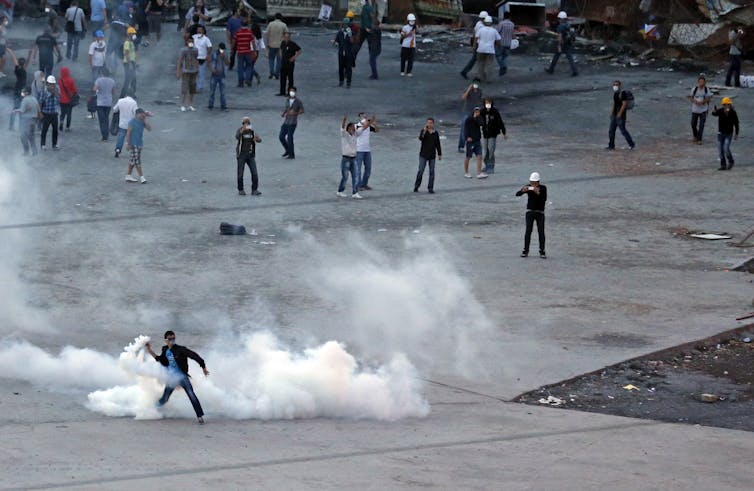After watching the new Netflix documentary series Making a Murderer, huge numbers of viewers have taken to social media to express outrage and advocate for the release of Steven Avery, the subject of the 10-episode series.
The hashtags #FreeStevenAvery and #stevenaveryisinnocent have been trending on Twitter. Meanwhile, thousands have signed Change.org and White House petitions demanding that President Obama pardon Avery, who, in 2007, was convicted of murder in Wisconsin. (The White House responded that the president can pardon only prisoners convicted of a federal offense.)
These people aren’t knocking on doors or holding rallies outside the Wisconsin State House. Nonetheless, they are making noise. While the White House has claimed that its hands are tied, could these social media activists (sometimes derided as “slacktivists”) end up making a difference?
In an article recently published in PlosOne, my coauthors and I analyzed the effect of this type of online activism – the way it interacts with other online media, and how online networks work to amplify the activists’ message.
The changing nature of protests
In the past, political activism was largely hamstrung by poor communication technology. On July 14, 1789, when a group of Parisians stormed the Bastille, news of the event could travel only as fast as the messengers carrying them.
Today, digital technologies overflow, in real time, with information about what people are doing around the planet. We’ve grown so used to technology playing a role in political action that it’s difficult to imagine how events must have unfolded in a world devoid of social media. If Stanislas-Marie Maillard, one of the leaders of the attack on the Bastille, had carried a smartphone, surely he would have tweeted a picture of the crowd rushing into the fortress – perhaps even a selfie.
We’ll never know if it would have made any difference for 18th-century revolutionaries to have had access to the digital networks that we now monitor idly from the palm of our hands. But we do know that networked technologies are making a difference today for activists and political mobilization.
However, for years, many dismissed social media as an engine for social change.
Some claimed that online networks were unable to stir political action to the same degree as traditional, face-to-face interactions. Others have argued that social networks encourage a sort of feel-good activism – signing an ePetition, joining Facebook groups or changing a profile picture – that suggests little true commitment to a political cause, and causes almost no larger impact.
What these accounts failed to acknowledge is that online networks help build a different kind of political identity, more liquid in its manifestation, less constrained by physical proximity. And, most crucially, online networks help raise awareness with unprecedented speed. During the first hours of the Ferguson demonstrations, for instance, journalists learned about the events through their Twitter feeds, not from their own news organizations.
Nonetheless, in this digital era, the term “slacktivism” has become a common figure of speech to talk about lightweight political engagement. It’s used to paint those who trivially like or retweet content in a negative light.
While it’s a bit of an oxymoron to talk about activists and slackers as the same people, it’s true that many people only make shallow contributions to a political cause – changing their profile pictures, sharing a post or using a trending hashtag.
And yet these actions sometimes escalate to the point of shaping the news agenda and directing attention to previously ignored political issues. The 2011 Occupy movement in the U.S., the 2013 Gezi Park protests in Turkey, the 2014 umbrella revolution in Hong Kong – all serve as examples of how digital technology can amplify political action.
Why does this happen?
Here’s one way to think of it: like a piano, the volume of information that travels through networks responds to the speed with which we hit the keys. Online, there are many hands pressing the keys which – to continue with the metaphor – help speed up the hammer and make the sound of the notes reverberate and come out louder.
This is the moment when a hashtag becomes a trending topic, and public attention is directed to a new cause.
The critical periphery
It’s crucial to understand how so many hands converge to the same tune, and here is where networks become more than a convenient shorthand for everything digital: they offer a tool to understand how something small (an incipient protest, a political claim, a new hashtag) becomes big in a matter of days, if not hours.
Research tells us that networks are very different in how they look and operate. We could argue that, like people, they share a basic DNA; but the manifestations are as varied as the personalities of your fellow humans. Some networks are more conducive to chain reactions than others; others are more likely to limit the flow of information among small groups of people. And both types of networks can emerge online, depending on how we use social media.
So to understand the role slacktivists play in political action, we have to understand how they integrate within the social media networks – and how this influences the conduits through which a movement can mobilize resources and build up visibility.
This is what my coauthors and I did in a recent paper. We analyzed the online activity connected to certain political events, including the Gezi Park protests in Turkey. We reconstructed the network of retweets to map the flow of information, and we identified the users that were on the streets using geolocation tags. These users were at the core of the information network.

We found that the vast majority of people using protest hashtags were only peripherally involved in the process of building up momentum. These users engaged only occasionally with the messages, photos and videos posted from the ground. They retweeted this content every now and then but, on an individual basis, produced very little new information.
Collectively, however, they were a force: these users formed what we call the critical periphery, and they played a crucial role in amplifying the message of the core protesters. As a unit, peripheral users were the many hands that made the piano strings vibrate faster – increasing the volume and making the movement’s voice grow louder.
So is slacktivism worth it? At the time, the taking of the Bastille didn’t seem to matter much: there were only seven prisoners deprived of their freedom behind those walls. However, today we look at that event as one of the defining moments of Western history, especially for what it now represents in people’s imagination.
Likewise, it would be wrong to dismiss the impact of social networks. Through social media, people can challenge old hierarchies, deciding when and how they convey their message. The documentary Making a Murderer introduced many people to Steven Avery’s case for the first time, but it’s been the viewers who have taken to social media who are making sure the story doesn’t end with the series’ credits.
And perhaps their collective voice will resonate to the point that Wisconsin’s political and judicial leadership will no longer be able to ignore it.

